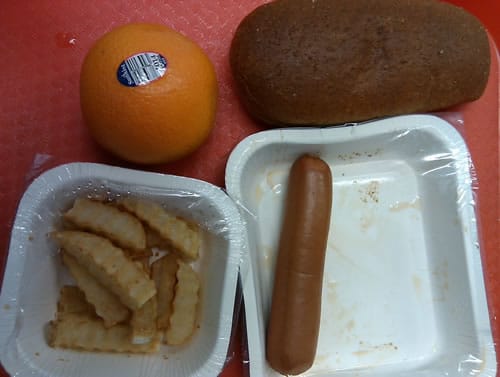School Lunch
Oct 26, 2010, Updated Aug 11, 2017
As both a mom and a public school teacher, “Mrs. Q” became so dismayed at the disgusting school lunches that she had to do something to raise awareness and help bring about change. So she decided to eat school lunch every day, just like the kids do, and share the meals and her experiences at Fed Up With Lunch: The School Lunch Project.
She blogs anonymously, which drives home the point that it’s not just her school that has lousy food — it could be any school in any town across the country.
I met her recently (at a secure, undisclosed location, of course), and we became fast friends. Naturally, I couldn’t wait to ask her a few questions about all the processed, packaged food the kids are given, and more importantly, how we can start to improve it.

You’ve gotten a lot of attention by simply eating school lunch every day — and blogging about it. Why are people so interested in what you’re doing?
Frankly it surprised me when I started getting so much attention after just two weeks of blogging. I think there are a few reasons. First, I’m anonymous, which makes people wonder. Second, I happened to start a blog about school lunches right as the topic entered the national discussion early this year (The Let’s Move campaign started in January and Jamie Oliver’s show Food Revolution came out in March). Third, I’m doing something most people are pretty revolted by: Eating school lunch — and for a full year, no less. Fourth, I’m taking pictures with my cell phone and it feels vaguely undercover and gritty. There is an aspect of morbid curiosity and voyeurism.
What’s so bad about the school lunches?
Where do I start?
- At my school many of the kids look to the school for the best meal of the day or potentially their only meal. So if we are feeding them overly-processed foods with few fresh fruits and veggies, they have no good food models in their lives.
- The USDA regulations are confusing and let school districts get away with offering pizza and fries every day.
- Lunch has been shortened to a pitiful 20 minutes including lining up with the tray and then cleaning up. It’s not enough — these are children who are still learning how to feed themselves.
- Lunch ladies touch the lives of every student in the school, yet their profession has been denigrated from respected chef to server with little control. How did we agree to that shift?
What’s the worst meal you’ve encountered? The best?
The worst meal I had was the cheese lasagna, which was not even pasta anymore: It was just crumbly white stuff. I ate two bites and was done. I really like the “tex-mex,” which is taco meat over rice with beans on the side. Close to real food and certainly comfort food for me.
Have you noticed that your “tastes” or food preferences have changed since you started the project?
It’s really been a roller coaster ride for my taste buds. For example, I was turned off by the pizza initially, but then I started liking it, then I got sick of it again. Recently I’ve wondered if I have gluten sensitivity and I didn’t eat the pizza once, which bothered some readers who thought I was straying from my original purpose. I used to hate the fruit cups, but now I happily drink the juice down.
In my real life I am eating 100% differently than I did before the project. A year ago I was drinking milk and eating anything I liked. Now I am totally dairy free and I’m eating very limited gluten at home. I’m going to eat school lunch and eat the pizza through the end of 2010. I haven’t decided what kind of “detox” I’ll need to do at the end of the year, but I have a feeling I will be going gluten-free. A reader called me “uber granola,” which made me laugh. Before starting the project I laughed when a close friend went gluten-free. I thought she was truly crazy. Now I might be going that same direction… When I say that the school lunch project completely changed my relationship with food, I’m not lying.
Obviously you’re coming at this from an adult’s perspective. What do the kids think about the food?
The worst thing for the kids is that there isn’t time to eat all of the food. One day when they were serving “tex-mex,” which like I said before is one of my favorite meals, a student mentioned that he only drank the chocolate milk and the juice from the fruit cup. That was it. I couldn’t get a straight answer on whether or not it was not having enough time to eat the food or that he didn’t like the food. Whatever the case it’s a shame.
Kids love hot dogs, pizza, and chicken nuggets. Other main entrees, veggies, and fruit are often rejected due to lack of exposure. Nutrition/cooking education has to be part of successful school lunch reform.
Additionally, we need to stop with the “children’s menu” mentality. Children need to try and eat the same foods as adults. I can’t tell you how dismayed I am when I go to favorite ethnic restaurants and I see children’s menus with American processed foods. My husband loves Indian food and his favorite restaurant has a children’s menu with chicken nuggets. We make sure to order enough Dal and Palek Paneer for us and our son, but we will see Indian families eating Naan and Masala Dosa while their kids eat fries and chicken nuggets. My heart hurts when I see that.
Why is it important for us to improve the quality of school lunches?
Look, our country is suffering because everyone including me has a low Food IQ. I’m learning and getting better, but most of us don’t have a clue about healthy foods or how to prepare them. I believe that if we fix school lunch, we start fixing other problems like no one knowing how to cook. I can’t “wing it” in the kitchen — I don’t have those skills and now that I have a little one at my feet I have little time for food prep. When Jamie Oliver said we needed a Food Revolution, he was right. It starts at school, but there needs to be some kind of nutrition outreach within the community so that people can learn how to feed themselves again and stop depending on fast food chains and the dollar menu.
If we don’t change school lunches, we will see a continued rise of obesity and the accompanied skyrocketing cost of health care in this country. This is not a “fat” issue, but a nutrition issue: Even the skinny kids at my school need better school lunches so their nutritional needs are more fully met.
If you could change one thing about school lunch, what would it be?
I would like to see every school get a salad bar (along with basic nutrition education), offer fresh fruits and veggies and reduce our reliance on overly processed food-like substances. One reader called me a “hippie,” but I certainly don’t think we need to go gluten-free or offer only organic for school lunch. Those kinds of lunches on totally on the other side of the spectrum from what I’m eating. No, we just have to take some small steps so that school lunches can stay in lock step with the latest in nutrition research: Fresh fruit and veggies are vital to health and should be introduced at a young age, and processed food kills.
What are some resources for people who want to get involved?
If you are a parent, see if you can eat school lunch with your kid. Don’t trust the words you see on the menu: There are a lot of colorful descriptors that hold little value. For example, “meatloaf” is on the menu at my school, but it’s a patty (there was never a loaf of any kind). “Pineapple tidbits” are on the menu too and refer to shredded pineapple in a fruit cup. Parents should also do some homework and find out if the food in the cafeteria is coming from an outside food company or if it is cooked onsite. Seek out other concerned parents of your kid’s friends and/or join the PTA. Talk to your student’s teacher. The best way to change things is to start a conversation inside the school. Join or start a School Wellness Committee. Every school district that accepts federally subsidized funds needs to have a “Local School Wellness Policy,” which is a district-wide document. Find that policy (usually online) and use it to open a dialogue about school food with members of your community.
—
Don’t miss Mrs. Q’s recent article at Change.org, 5 Ways Parents Can Reform School Food Overnight.





















Thank you to Mrs. Q for taking the time to answer my questions so wonderfully, and thanks everyone for your insightful comments! School Food is an important issue, and although it’s “hot” right now, it’s important we all stay on top of it — and keep pushing for reform and improvement!
Without quality food (and enough time to eat it), there’s no way our students can reach their full potential. I believe that the future of our country, quite literally, depends on our improving school lunches! Keep up the good fight!
Mrs. Q and other Parents and Teachers,
For those of you in the Pacific NW looking for a way to support change, Experience Food Project (www.experiencefoodproject.org) is a non-profit focused on bringing unprocessed food and education into our schools. Their mission is to provide quality programs and authentic food experiences that create healthy communities and sustainable food systems. Their program is wholistically integrated into both the lunchroom and the classroom with a positive track-record in the changes they’ve made.
Love this! It’s a shame it’s only in Washington… 🙂
Thanks so much for letting me participate in #unprocessed. I wish I could take the pledge, but I’m eating processed food right now. Maybe next year!
My kids have always been homeschooled and are now in 4th and 6th grades. Both are still homeschooled but also attend an ALE (Alternative Learning Environment–set up through the public schools) two days a week. Kids at the ALE have the option of running across the playground to the elementary school to buy lunch. I have heard reports of a slice of bacon in a hot dog bun and pizza with some kind of indescribable crust. It’s my kids’ first encounter with school lunches (we bag our own). They are horrified. Proof that, like Mrs. Q. says, “children’s menus” and “kids’ food” are manufactured phenomenons. Give the kids what adults eat (assuming, of course that it’s real and includes fruits and vegetables), grow some taste buds, grow healthy bodies. It’s definitely possible.
Hi – Great and enlightening post. I apologize in advance if this is an ignorant question, but why not send a packed lunch to school? Reform is obviously certainly in order, but don’t parents make lunches anymore? Even if a family is using food stamps (or in California the newly dubbed “Cal Fresh” program), a small but substantial-enough lunch from home would surely be better than the nasty meat stick in the photo. And 20 minutes?? That’s really appalling. Learning can’t be done without fuel and rest. From now on I’ll consider myself lucky that our local school district’s lunch “hour” is 40 minutes.
Even those lunches are a step up from my grown son’s old grade school (he’s now 25). They didn’t even have a cafeteria– they ate unpalatable MREs at their desks. We were NOT ALLOWED TO SEND FOOD TO SCHOOL. The children were forced to eat the microwaved crap from a truck. Needless to say, we switched schools.
Hello Ms. Q!! I agree that kids need longer than 20 minutes for lunch. At the elementary level, they not only need time to eat but time to run around! If we want to improve the overall health of our population we need to look at not just nutrition but also physical activity. Lack of physical activity is one of the main reasons Americans are overweight! I also agree that school lunches in many districts could be improved but I don’t agree that we need to completely eliminate “processed foods”. Obviously that term is a “catch all” for a whole range of products but it isn’t realistic or even necessary for everything to be “fresh.” If chosen wisely, a mix of fresh, frozen and “processed foods” can provide excellent nutrition for children as well as adults. For example, a lunch which consisted of low sodium minestrone soup (processed) , pasta… Read more »
I love this Q&A with Mrs. Q. Her passion really comes through, and I am thankful that she is shining a light on this sad issue. I think that there is a need for more of us to make a difference in how our communities eat. It always encourages me when I hear of schools involving their kids in food choices or in providing them food from the school gardens kids helped to grow. I feel like we’re making baby steps, but even those help propel us in the right direction.